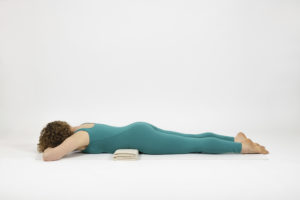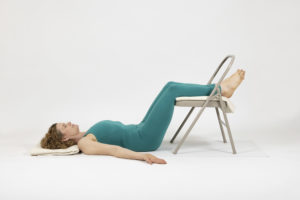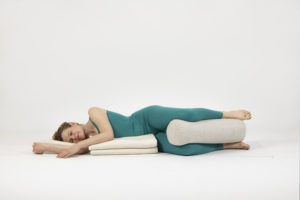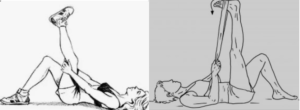
by Diana Perez PT, M.Sc., Yoga Therapist, Pain Care Aware Level 1 Certification
Caution: The following is not intended to be medical advice and you are strongly advised to seek out a professional medical opinion in order to be sure of how to best approach your specific condition.
Now that I have covered the anatomy and causes of sciatica in my post Yoga for Sciatica, Part 1: What is Sciatica and What Causes It, let’s look at how to manage this condition and how yoga can help.
In the 37 years that I have been practicing as a physical therapist, it has never ceased to amaze me how every person’s situation is so particular and specific to them. Treatment programs must be tailored to the specific needs of each individual, and very rarely can a cookie cutter approach be used even if the diagnosis appears to be the same.
It is also important to remember that health and wellness are dependent on bio-psycho-social-spiritual aspects unique to each individual. So it would be remiss of me to not remind you that all dis-ease in the body usually has multiple causes that can include the physical, energetic, emotional, mental and spiritual koshas/layers. All of these must be addressed in order to properly recover from, manage and prevent dis-ease. And few approaches are better at this than yoga and yoga therapy.
Many of the yoga practices have been well documented to be effective in addressing pain, manage and reduce stress, improve functional movement and ability to engage in activities of daily living and as well as help with various mental and physical conditions. There are also several studies that show improvements specifically in low back pain (with or without sciatica) through the practice of yoga.
The best approach to recover from sciatica depends on many factors, including the cause, the stage of the condition (acute—approximately 1-4 weeks, post-acute—approximately 4-12 weeks, or chronic—more than 3 months) , the level of the impairment and pain, and specific characteristics of the individual, their job and their lifestyle. Below are some general recommendations that might be helpful. These are divided into suggestions for the acute phase and the post-acute stages. But please remember that not all of the general recommendations below may be appropriate for you! And if any of these make your condition worse, please discontinue them.
Warning: Please see the final section of the post “Important Considerations” for some warning signs that should prompt you to seek medical help, in some cases immediately.
General Recommendations
In addressing sciatica, knowing the source of the sciatica and what caused it would be extremely helpful in deciding what action plan to take. Unfortunately, it is not always so easy to figure this out! Seeking the guidance of a medical professional (that ideally has yoga training), a yoga therapist, or a yoga teacher (with experience in this area) will greatly assist in this objective. But financial or lack of resources may make this difficult or impossible. So, you might want to try to deal with your sciatica yourself by following some of the following guidelines and recommendations.
Acute Phase (1-4 weeks)
Usually, when someone initially presents with sciatica, particularly when there is a lot of acute pain, the recommendation given is to rest and avoid all activities and positions that exacerbate the condition. This rest is meant to be short term (usually no more than 1-2 days), after which the person is best to break up the periods of rest with some movement, such as short walks and possibly some gentle stretches. Examples of some yoga poses that might be useful as gentle stretches are Pavana Muktasana (Double Leg Wind Relieving pose and Single Leg Wind Relieving pose), Baddha Konasana (Bound Angle pose aka Butterfly), and Sucirandhrasana (Figure 4). Avoid all twists at this stage.
Medications (as recommended by your health care professional), ice and or heat may be helpful in controlling or decreasing the pain. When standing, sitting, or walking, some people benefit from the use of a back brace.
Resting in certain yoga positions can be helpful. Lying on your back in Savasana with the legs elevated on a pillow, blanket stack, or chair seat, is very helpful for many people.

For some people lying on their belly, or even in Sphinx pose (Salamba Bhujangasana) position, can reduce the sciatic pain.

Yet other people seem to get better relief of pain by laying on their side with a pillow between their legs.

However, none of these positions, particularly the ones on the stomach, should be used or continued if it increases the leg pain.
For most people, prolonged sitting (or any sitting), prolonged standing and activities which require even a minimal amount of forward bending (like brushing your teeth, washing the dishes or mopping/vacuuming) increase the sciatic pain and symptoms and are to be avoided or modified so that there is no increase in pain/symptoms. Also try to avoid activities or movements that increase intra-abdominal pressure, such as when holding your breath, forcing to have a bowel movement, or lifting heavy objects.
Many of my patients get sciatica during periods of unusually heavy stress, emotional distress, or prolonged stress that leads to fatigue/burn out/mental health issues (anxiety and depression). There are occasions when the sciatica comes from an injury or unique physical effort but then the stress that ensues from being in pain and not being able to pursue life as usual can prolong the recovery. So, managing stress is an important component to recovery and prevention of sciatica.
Almost all of the yoga practices have been shown to have some benefit in reducing stress: pranayama, meditation, visualizations, asana (with appropriate poses and movements that match the stage of the condition), restorative yoga, yoga nidra, etc. And because of the effects of yoga on various general body systems (central nervous system, hormones, immune system, etc.) these same practices are in fact the same tools that can be used to reduce and control pain, and help manage stress, depression, and anxiety. See Stress Management for When You’re Stressed for general information about reducing stress. See Practicing Yoga for Depression: An Overview for information about depression and Yoga for Anxiety: The Big Picture for information about anxiety.
Yoga can also be very helpful for managing chronic pain. See All About Pain Management and Yoga for an overview. Many of my patients use meditation apps or YouTube videos to guide them through various progressive relaxation, meditation, and breathing practices.
Post-acute Phase (4-12 weeks)
As your condition improves, you can start to increase the walking time, and add some additional gentle yoga poses or additional stretches that feel good and do not increase your pain. Some of the poses you might add to those suggested in the acute phase include:
- Supta Padangusthasana (Reclined Leg Stretch), with bottom leg bent and hands behind knee or holding a strap around the foot.

- Supta Sucirandhrasana (Windshield Wiper pose). See here for information.
- Salamba Bhujanghasana (Sphinx pose) and Bhujanghasana (Cobra pose). See here for information.
- Dandayamana Bharmanasana (Bird Dog aka Hunting Dog pose). See here for information.
- Phalakasana (Plank pose), on your knees and eventually on your toes. See here for information.
- Reclined Single Leg Raises (with the other leg bent and foot on floor). See here for proper instructions on how to perform this exercise at the stage of the condition.
This is also a good time to address any factors that might be causing or aggravating the condition. These include poor posture, prolonged sitting or work positions and movements, lack of movement and exercise, poor flexibility or muscular tone, poor workstation ergonomics (bad chairs, position of computer screens, etc.).
With continued improvement, you can increase the intensity of your yoga practice. How you progress the yoga poses depends very much on the cause of the sciatica (as described Part 1). It is beyond the scope of this blog to address the specific poses and exercises that would be done for each of the various causes, but generally movements and poses that you are to avoid or be very cautious with initially during this phase are twists, all seated forward bends, standing forward bends (particularly when the weight of the torso is not supported by the arms or the bending involves rounding of the spin), and asymmetrical standing poses. As with rest, these restrictions of movement are meant to be temporary and ideally over time you will want to regain normal functional movement in all directions.
Finally you should look to preventing future episodes of sciatica. In addition to addressing the lifestyle or situation that caused the sciatica, a regular program of exercise will be of paramount importance. Yoga, including an active asana practice, has proven to be very beneficial in the prevention of recurrence and/or the long-term management of sciatica and other back problems.
Important Considerations
Symptoms that require immediate medical consultation:
- Loss of bladder or bowel control.
- Pain or numbness in the pelvic floor/testicular area.
- Loss of control of the foot (it drops when you try to walk), or significant loss of strength in the leg.
- Your foot/leg weakness or pain is resulting in a loss of balance or falling.
Symptoms for which you should seek the advice of a medical professional:
- Your sciatic pain is severe and constant.
- You are unable to sleep at night for a prolonged period of time.
- Your pain lasts more than 4-6 weeks and does not improve or improves only slightly.
 Diana Perez is a sports and rehabilitation Physical Therapist and a certified Professional Yoga Therapist (PYTI-2017) who has worked in the medical field, academia, and fitness industry for over 40 years. She completed a Masters Degree in Rehabilitation Science in 1997 (Faculty of Medicine; McGill University) and was a lecturer / professor at the School of Physical & Occupational Therapy; Faculty of Medicine (McGill University) from 1985-2004. She has advanced specializations in Sports Physiotherapy, Manual Therapy, Back & Neck Rehabilitation, Muscle Energy, and Myofascial Release, She also has formal training/certifications in the areas of wellness, functional nutrition, naturopathy, Ayurvedic medicine, acupuncture and yoga therapy, and has been integrating yoga into her clinical practices since 2004.
Diana Perez is a sports and rehabilitation Physical Therapist and a certified Professional Yoga Therapist (PYTI-2017) who has worked in the medical field, academia, and fitness industry for over 40 years. She completed a Masters Degree in Rehabilitation Science in 1997 (Faculty of Medicine; McGill University) and was a lecturer / professor at the School of Physical & Occupational Therapy; Faculty of Medicine (McGill University) from 1985-2004. She has advanced specializations in Sports Physiotherapy, Manual Therapy, Back & Neck Rehabilitation, Muscle Energy, and Myofascial Release, She also has formal training/certifications in the areas of wellness, functional nutrition, naturopathy, Ayurvedic medicine, acupuncture and yoga therapy, and has been integrating yoga into her clinical practices since 2004.
Diana Perez has been practicing yoga since 2002 and teaching yoga since 2004. Her yoga influences have been mainly from the schools of Hatha, Ashtanga, Moksha and Anusara and she completed 2 teacher training certifications (Hatha & Ashtanga; RYA-200 hours). Her specialties are in Yoga Therapy, Yoga Anatomy, Injury Prevention, Asana Alignment, and Yin Yoga. She is on the faculty of several Yoga Teacher Training Programs in Canada (Sun and Moon; Heaven & Earth; Happy Tree; Moksha WI Yin), and teaches yoga classes and many types of workshops to yoga teachers as well as to the general public. She is also on the faculty of the Atlas-Medic Medvox Program for who she develops and teaches courses to health care professional on how to integrate yoga into health care. She currently continues to practice as a physiotherapist and yoga therapist at the Medi-Club Physio Centre in the West Island of Montreal.
• Follow Yoga for Healthy Aging on Facebook and follow Nina on Instagram • Order Yoga for Times of Change here and purchase the companion videos here • Order Yoga for Healthy Aging: A Guide to Lifelong Well-Being here.


Leave A Comment